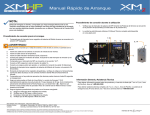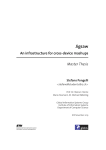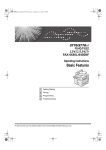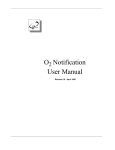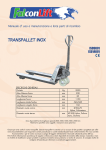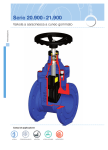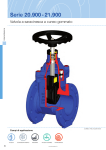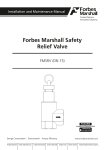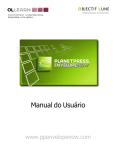Download Piston Valve - Forbes Marshall
Transcript
Installation and Maintenance Manual Piston Valve PSVAL ProductHUB Installation and Maintenance Guide ANDROID APP ON G oogl e play Forbes Marshall Forbes Marshall Arca Codel International Krohne Marshall Forbes Solar Forbes Vyncke Forbes Marshall Steam Systems Table of Contents 1. Preface .................................................................................1 2. Important Safety Notes .........................................................1 3. Brief Product Information ......................................................3 4. Operation ............................................................................11 5. Installation Guidelines ........................................................11 6. Start-up and Commissioning ...............................................12 7. Maintenance Guidelines .....................................................12 8. Troubleshooting ..................................................................19 9. Available Spares .................................................................21 10. Warranty Period ..................................................................21 PLEASE NOTE - Throughout this manual this cautionary symbol is used to describe a potential damage or injury that might occur if the safety considerations are overlooked. This symbol denotes CAUTION, WARNING or DANGER. Piston Valve 1. Preface: This manual is intended for anyone using, commissioning, servicing, or disposing the below mentioned products safely and efficiently. Piston Valve [PSVAL] Size: DN15 (½”) / DN20 (¾”) / DN25 (1”) / DN32 (1 ¼”) / DN40 (1 ½”) / DN50 (2”) / DN65 (2 ½”) / DN80 (3”) / DN100 (4”) / DN125 (5”) / DN150 (6”) / DN200 (8”) PLEASE NOTE: Throughout this manual the following cautionary symbol is used to describe a potential damage or injury that might occur if the safety considerations are overlooked. 2. Important Safety Notes: Read this section carefully before installing/operating/maintaining the product. The precautions listed in this manual are provided for personnel and equipment safety. Furthermore, Forbes Marshall accepts no responsibility for accidents or damage occurring as a result of failure to observe these precautions. Note that the product is designed to perform for non-contaminated fluids only. A contamination in the form of chemical, foreign particle etc. can lead to problem with product performance and life of the product. If these products in compliance with the operating instructions are, properly installed, commissioned, maintained and installed by qualified personnel (refer Section 2.7) the safety operations of these products can be guaranteed. General instructions for proper use of tools and safety of equipments, pipeline and plant construction must also be complied with. 2.1 Intended use: Check if the product is suitable for intended use/ application by referring to the installation and maintenance instructions, name plates and technical information sheets. i) The product is suitable for use as defined in the technical information sheet. In case the need arises to use the product on any other fluid please contact Forbes Marshall for assistance. ii) Check for the suitability in conformance to the limiting conditions specified in technical information sheet of the product. iii) The correct installation and direction of fluid flow has to be determined. iv) Forbes Marshall products are not intended to resist external stresses, hence necessary precautions to be taken to minimize the same. 2.2 Accessibility and Lighting: Safe accessibility and working conditions are to be ensured prior to working on the product. PSVAL 1 2.3 Hazardous environment and media: The product has to be protected from hazardous environment and check to ensure that no hazardous liquids or gases pass through the product. 2.4 Depressurizing of systems and normalizing of temperature: Ensure isolation and safety venting of any pressure to the atmospheric pressure. Even if the pressure gauge indicates zero, do not make an assumption that the system has been depressurized. To avoid danger of burns allow temperature to normalize after isolation. 2.5 Tools and consumables: Ensure you have appropriate tools and / or consumables available before starting the work. Use of original Forbes Marshall replacement parts is recommended. 2.6 Protective clothing: Consider for the requirement of any protective clothing for you/ or others in the vicinity for protection against hazards of temperature (high or low), chemicals, radiation, dangers to eyes and face, noise and falling objects 2.7 Permits to work: All work to be carried out under supervision of a competent person. Training should be imparted to operating personnel on correct usage of product as per Installation and Maintenance instruction. “Permit to work” to be complied with (wherever applicable), in case of absence of this system a responsible person should have complete information and knowledge on what work is going on and where required, arrange to have an assistant with his primary goal and responsibility being safety. “Warning Notices” should be posted wherever necessary. 2.8 Handling: There is a risk of injury if heavy products are handled manually. Analyze the risk and use appropriate handling method by taking into consideration the task, individual, the working environment and the load. 2.9 Freezing: Provision should be made to protect systems which are not self-draining, against frost damage (in environment where they may be exposed to temperatures below freezing point) to be made. 2.10 Returning products: Customers and Stockist are reminded that, when returning products to Forbes Marshall they must provide information on any hazards and the precautions to be taken due to contamination residues or mechanical damage which may present a health, safety or environmental risk. This information must be provided in writing including Health and Safety data sheets relating to any substances identified as hazardous or potentially hazardous. 2 Piston Valve 3. Brief Product Information: 3.1 Description: Forbes Marshall Piston Valves, PSVAL, provide perfect tightness and durable stability on different media such as steam, superheated steam, heat transfer fluid, water and compressed air. DN 15 / 20 DN 25 DN 32 / 40 Figure 1: Piston Valve DN 65 to 200 DN 50 3.2 Sizes and Pipe Connection: 1. DN 15 / 20 / 25 / 32 / 40 Screwed BSPT / NPT, socket weld ends, flanged to class 150 / 300 / 600 available on special request 2. DN 50 / 65 / 80 / 100 / 125 / 150 / 200 Flanged to class 150 / 300 3. DN 50 / 65 / 80 / 100 / 125 / 150 / 200 Flanged to PN16 / PN25 / PN40 For higher sizes DN 250 and 300 contact Forbes Marshall 3.3 Limiting Conditions: For DN 15 / 20 / 25 / 32 / 40 Socket weld ends Maximum operating pressure Maximum operating temperature Maximum hydraulic test pressure 78 bar g 425 deg c 156 bar g (IBR requirement) For DN 15 / 20 / 25 Screwed ends Maximum operating pressure Maximum operating temperature Maximum hydraulic test pressure PSVAL 78 bar g 425 deg c 156 bar g (IBR requirement) 3 For DN 32 / 40 Screwed ends Maximum operating pressure Maximum operating temperature Maximum hydraulic test pressure 41.5 bar g 425 deg c 83 bar g (IBR requirement) Body design conditions : DN 15/20/25/32/40 Class 600 Flanged ends Maximum allowable pressure Maximum operating pressure Maximum operating temperature Maximum hydraulic test pressure 41.5 bar g 425 deg c 83 bar g (IBR requirement) 156 bar g Body design conditions : DN 50-200 PN 16 Flanged End Maximum allowable pressure Maximum operating pressure Maximum operating temperature Cold hydraulic test pressure 16 bar g at 38 deg C 16 bar g at 204 deg C 425 deg C at 9.1 bar g 24 bar g Body design conditions : DN 50-150 PN 25 Flanged End Maximum allowable pressure 25 bar g at 38 deg C Maximum operating pressure 25 bar g at 226 deg C Maximum operating temperature 425 deg C at 14 bar g Cold hydraulic test pressure 38 bar g Body design conditions : DN 50-200 PN 40 Flanged End Maximum allowable pressure Maximum operating pressure Maximum operating temperature Cold hydraulic test pressure 40 bar g at 38 deg C 39 bar g at 250 deg C 425 deg C at 22.8 bar g 60 bar g Body design conditions : DN 15-200 Class 150 Flanged ends Maximum allowable pressure Maximum operating pressure Maximum operating temperature Cold hydraulic test pressure 19.6 bar g at 38 deg C 14 bar g at 197 deg C 425 deg C at 5.5 bar g 28 bar g (IBR requirement) Body design conditions : DN15-200 Class 300 Flanged End Maximum allowable pressure Maximum operating pressure Maximum operating temperature Cold hydraulic test pressure 4 51 bar g at 38 deg C 41.5 bar g at 253 deg C 425 deg C at 28.8 bar g 83 bar g (IBR requirement) Piston Valve Figure 2: DN15, 20, 25 Piston Valve Figure 3: DN32, 40 Piston Valve Note: Always open and close piston valve fully, do not use valve or ‘F key. Material: DN 15-40: No. Description Material Standard 1 Body Forged Carbon Steel ASTM A105N 2 Bonnet Forged Carbon Steel ASTM A105N 3 Piston Stainless Steel ASTM A 276 TYPE 304 4 Spindle Stainless Steel ASTM A 276 TYPE 410 5 Nyloc Nut Carbon Steel 6 Stud Carbon Steel ASTM A193 Gr. B7 7 Nut Carbon Steel ASTM A 194 Gr.2H 8 Belleville Washer Spring Steel 50CrV4 9 Sealing stack S.S. Reinforced Graphite 10 Spacer Stainless Steel 11 *Handwheel Sheet Metal / SG Iron ASTM A 276 TYPE 410 12 Name Plate Stainless Steel 13 Grease Cap Stainless Steel SS 304 14 Gap ring Stainless Steel ASTM A 276 TYPE 410 ASTM A 240 TYPE 304 *Note :For DN 15-25 Handwheel - Sheet Metal | For DN32-40 Hand wheel-S.G. Iron Additional material: DN 40 Sr.No. Description Material 15 Split Nut Brass 16 Thrust Plate Stainless Steel Dimensions: (approx. in mm): Size (DN) A B C 15 20 25 32 40 PSVAL 110 110 126 165 165 118 118 133 175 175 146 146 165 215 215 DIN En12164 ASTM A 275 TYPE 420 Flange Class: Size (DN) *Tol ±1mm A* B C 118 118 133 175 175 146 146 165 215 215 Class 150 Class 300 Class 600 15 20 25 32 40 252 252 260 305 305 265 265 278 317 317 265 265 278 320 320 5 Figure 4: DN50 Piston Valve Note: Always open and close piston valve fully, do not use valve or ‘F key. Material: DN 50 Sr. No. Part Material Standard 1 Body Cast steel ASTM A 216 Gr. WCB 2 Bonnet Cast steel ASTM A 216 Gr. WCB 3 Piston Stainless steel ASTM A 276 Type304 4 Spindle Stainless steel ASTM A 276 Type410 5 Nyloc nut Carbon steel - 6 Stud Carbon steel ASTM A 193 Gr.B7 7 Nut Carbon steel ASTM A 194 Gr.2H 8 Belleville washer Spring steel 50CrV4 9 Sealing Stack S/S Reinforced Graphite - 10 Spacer Stainless steel ASTM A 743 Gr.CA15 11 Handwheel S.G. Iron - 12 Split nut Brass DIN EN12164 13 Thrust plate Stainless steel ASTM A 276 Type420 14 Name plate Stainless steel ASTM A 240 Type304 15 Gap Ring Stainless Steel ASTM A276 TYPE 410 Dimensions (approx. in mm) : Size DN 50 ANSI Class 6 No. of Holes T E F Weight 19 4 19 210 262 14.5 kg 19 8 22 210 262 17.5 kg 125 18 4 18 210 262 14.5 kg 125 18 4 20 210 262 17.5 kg L D PCD 150 203 152 121 200 267 165 127 PN 16/25 230 165 PN 40 230 165 H Piston Valve Figure 5: DN 65-200 Piston Valve Note: Always open and close piston valve fully, do not use valve or ‘F key. Material: DN 65-200: Sr. No. 1 2 3 4 5 6 7 8 9 10 11 12 13 14 15 16 17 18 19 20 21 22 23 24 PSVAL Part Body Bonnet Piston Body Sealing Stack Spacer Spindle Stem Split nut LH Nut Gland Sealing Slack Threaded Bush Back Seat Hex. Gland Nut Bonnet sealing stack Stud Nut Belleville washer Handwheel Nyloc nut Name plate Thrust plate Washer Grub screw Gap Ring Material Cast steel Cast steel Stainless steel S/S Reinforced graphite Stainless steel Stainless steel Stainless steel Brass Stainless steel S/S Reinforced graphite Ph. Bronze Stainless steel Stainless steel Graphite Carbon steel Carbon steel Spring steel S.G. Iron Carbon steel Stainless steel Stainless steel Stainless steel Hardened steel Stainless steel Standard ASTM A 216 Gr. WCB ASTM A 216 Gr. WCB ASTM A 351 CF8 ASTM A 743 CA 15 ASTM A 276 Type 410 ASTM A 276 Type 304 DIN En12164 ASTM A 276 Type 304 ASTM A 276 Type410 ASTM A 276 Type410 ASTM A 193 Gr.B7 ASTM A 194 Gr.2H 50CrV4 ASTM A 240 Type304 ASTM A 276 Type420 ASTM A 240 Type304 I.S. 12.9 ASTM A 276 Type 410 7 Dimensions (approx. in mm) : Size DN 65 to 200 Sizes (DN) Pressure Class L D PCD H NO. OF HOLES T E F Approx. Weight (Kg) 65 65 65 65 80 80 80 80 100 100 100 100 125 125 125 125 150 150 150 150 200 200 200 200 CLASS 300 CLASS 150 PN 16 / 25 PN40 CLASS 300 CLASS 150 PN 16 / 25 PN 40 CLASS 300 CLASS 150 PN 16 / 25 PN 40 CLASS 300 CLASS 150 PN 16 / 25 PN 40 CLASS 300 CLASS 150 PN 16 / 25 PN 40 CLASS 300 CLASS 150 PN 16 PN 40 292 216 290 290 318 241 310 310 356 292 350 350 400 356 400 400 445 406 480 480 559 495 600 600 191 178 185 185 210 191 200 200 254 229 220 235 280 254 250 270 318 279 285 300 381 343 340 375 149 140 145 145 168 152 160 168 200 191 180 190 235 216 210 220 270 241 240 250 330 298 295 320 22 19 18 18 22 19 18 18 22 19 20 24 22 22 18 26 22 22 22 26 25 22 22 30 8 4 8 8 8 4 8 8 8 8 8 8 8 8 8 8 12 8 8 8 12 8 12 12 25 22 18 22 28 24 24 20 32 24 18 22 35 24 22 26 37 26 22 28 41 28 24 34 335 335 335 335 320 320 320 320 395 395 395 395 446 446 446 446 486 486 486 486 591 591 591 591 400 400 400 400 384 384 384 479 479 479 479 479 540 540 540 540 598 598 598 598 728 728 728 728 31 27 27 31 37 31 31 37 58 47 47 58 87 70 70 87 117 90 90 117 210 164 164 210 8 Piston Valve 3.4 Operating Range: DN50-200 425 The product must not be used in this region. A 300 200 A - B Flanged ANSI 150 A - F Flanged ANSI 300 * PMO- Maximum operating Pressure 100 B F 0 10 14* 0 20 30 40 41.5* 51 Class 800 The product must not be used in this region. A - D Screwed and socket weld Pressure barg 0 Temperature C DIN PSVAL 425 400 The product must not be used in this region. 300 Steam Saturation Curve 200 100 B 0 0 5 10 15 C 20 25 D 30 35 40 45 A - B Flanged PN 16 A - C Flanged PN 25 A - D Flanged PN 40 Pressure barg PSVAL 9 Figure 6 : Exploded View of DN65-200 Piston Valve 10 Piston Valve 4. Operation: [Refer figure 5] The piston valve is operated manually by a handwheel (18) it should be either fully open or fully closed. To open the piston valve turn the handwheel (18) in the anticlockwise direction until it stops completely. To close the piston valve turn the handwheel (18) until it stop rotating further. Note: The piston valve spindle should be periodically checked to ensure adequate lubrication is present for efficient valve operation. For Lubrication 'Molykote M30' lubricating oil is recommended. When fitted on high temperature applications or where severe weather conditions prevail, the lubrication should be checked more frequently. Note: Never tighten bonnet nuts when piston valve is in open condition. Do not use piston valve for throttling which result in excessive wear of internals. Operation of the handwheel (18) should always be by the hand, it is not recommended to use a valve key or F key. If the handwheel is over-tightened, damage of the piston valve internals may occur. 5. Installation Guidelines: [Refer figure 7 and 8] Note: Before implementing any installations observe the 'Important Safety notes' in section 2. Referring to the installation and maintenance instructions, name – plate and technical information sheet check the product is suitable for intended installation. 1. The piston valve should be installed in the direction of fluid flow given by the arrow on the body. The preferred orientation is with the spindle vertical with handwheel on the top. The piston valve can be installed from the vertical to the horizontal plane. Note: Do not install the piston valve with handwheel on lower side as maintenance or lubrication of the piston valve will be difficult. The preferred orientation for installation The valve can be installed in vertical pipework Figure 7 : Correct orientation for installation Figure 8 : Incorrect orientation for installation PSVAL 11 2. 3. 4. 5. 6. Adequate space should be available while installation of the piston valve so that they can be conveniently operated and maintained. Before installing a piston valve, check to ensure that the size, pressure rating, materials of construction, end connections, etc. are suitable for the service conditions of the particular application. Remove the cover plugs from the ports. Note: Lubricate the product before installation as indicated if stored for more than 6 months. Care must be taken to ensure before installing the piston valve that the line is clear from all foreign particles such as welding fluxes, metal burr and dirt and maintain cleanliness during installation since the introduction of foreign particles can result in damage to the piston and sealing stack. When a socket weld piston valve is being installed the welding should be carried out to an approved procedure to a recognised standard. During welding the piston valve should be in the open position to allow maximum heat dissipation. Ensure that the discharged flow is directed to a safe place. 6. Start-up and Commissioning: 6.1. Flushing of lines: As part of pre-installation all fluid handling equipment particularly piping should be thoroughly cleaned of scale and the internal debris which accumulates during construction. This is accomplished by blowing or flushing with air, steam, water and other suitable medium. Note: For a detailed procedure on flushing of lines please visit Forbes Marshall website. 6.2. Commissioning: After installation or maintenance ensure that the system is fully functioning by confirming fluid is passing through it. 1. After flushing of lines is complete, open the piston valve fully by rotating handwheel in anticlockwise direction. 2. Operation of the handwheel should always be by hand. 3. Check for leaks and attend if any. 7. Maintenance Guidelines: Note: Before undertaking any maintenance of the product it must be isolated from both supply line and return line and ensure pressure is normalized to atmosphere. The product should then be allowed to cool. When re-assembling ensure that all joint faces are clean. Once completed open the product slowly and check for leaks. 12 Piston Valve 7.1. Routine and preventive maintenance: Please refer to the maintenance schedule mentioned in the table below to undertake routine maintenance of the piston valve. PARAMETERS TO BE CHECKED SR. NO. PISTON VALVE FREQUENCY FOR CHECKING VARIOUS PARAMETERS Daily Half Weekly Monthly Quarterly yearly 1 Manually Operate the valve. 2 Lubrication of piston valves. Y 3 Visual inspection and cleaning of stem-piston threads. Y 4 Refilling of *Loctite Anti-Seize (in grease cap) for DN 15/20/25. Annually Y Y *Loctite Anti-seize threaded compound 767 high performance conforms to ML-A-907-E. 7.2. Tool Kit: To carry out maintenance of the piston valve refer the tools mentioned in the table below. . Sizes DN15 /20/25 DN32/40/50 DN65/80/100/125 Component Tool used & size M 10 Stud Stud runner M10 x 1.5 Nut Box spanner of 17 mm (A/F) Nyloc nut Box spanner of 13 mm (A/F) Sealing stack Insertor tool (Available as spares) Sealing stack Extractor tool (Available as spares) M12 Stud Stud runner M12 x 1.75 Nut Box spanner of 17mm (A/F) Sealing stack Insertor tool (Available as spares) Sealing stack Extractor tool (Available as spares) M16 Stud Stud runner M 16 x 2A Nut Box spanner of 24 mm (A/F) Sealing stack Insertor tool (Available as spares) Sealing stack Extractor tool (Available as spares) M20 Stud Stud runner M20 x 2 Nut box spanner of 30mm (A/F) Sealing stack Insertor tool (Available as spares) Sealing stack Extractor tool (Available as spares) M24 Stud Stud runner M24 x 3 Nut Box spanner of 36mm (A/F) Sealing stack Insertor tool (Available as spares) Sealing stack Extractor tool (Available as spares) DN40/50/65/80 Split nut tightening Open spanner of 20mm (A/F) DN 100/125/150/200 Split nut tightening Open spanner 24 mm (A/F) DN 150 DN200 PSVAL 13 7.3. Recommended tightening torques for bonnet nuts, gland nuts and Kv values Size DN15/20 DN25 DN32/40 DN50 DN65/80 DN100/125 DN150/200 Part No. 7 7 7 7 16 16 16 Component Nut Nut Nut Nut Nut Nut Nut Torque Range 3 – 5 Nm 5 – 7 Nm 18 – 20 Nm 20 – 25 Nm 50 – 60Nm 70 – 80Nm 80 – 90Nm Table 1 : Recommended tightening torques for bonnet nuts Size DN65/80 DN100/125 DN150 DN200 Part No. 13 13 13 13 Component Gland Nut Gland Nut Gland Nut Gland Nut Torque Range 35 - 45Nm 75 – 85 Nm 80 – 90 Nm 95 – 110 Nm Table 2: Recommended tightening torques for gland nuts Size DN15/20 DN25 DN32/40 DN 50 DN65 DN80 DN100 DN125 DN150 DN200 Kv Values 2.5 5.8 13 41 51 77 131 194 221 438 Table 3: Kv Values 7.4. Maintenance of size DN15 -50 piston valve : [Refer Figure 2, 3 and 4] Note: The graphite sealing stacks contain thin stainless steel support rings which may cause physical injury if not handled and disposed carefully. Maintenance of piston valve is very easy and can be done when valve is not in operation. If any leakage is observed through the bonnet hole, close the valve till handwheel (11) touches bonnet (2) then tighten all nuts (7) equally by half or one turn until leakage stops. (Refer Table 1 for recommended tightening torques). Note: Never tighten nuts (7) when valve is in open condition. If leakage still does not stop then follow the procedure mentioned below. 14 Piston Valve 1. Keep piston valve fully open remove nuts (7) & Belleville washer (8) turn handwheel (11) in clockwise direction till it stops at the top. 2. Pull handwheel (11) carefully along with bonnet (2) to remove piston (3) from body (1). 3. Avoid any damage to piston (3). 4. Clean piston (3) with lint free cloth. 5. Remove top sealing stack (9) with the help of extractor tool, remove spacer (10) [which is free in the body (1)] and remove bottom sealing stack (9) with the help of extractor tool. Replace with new set of bottom sealing stack (9), place spacer (10) and replace top sealing stack (9) with the insertor tool. Use mallet to apply light strokes on insertor tool ensuring they fit perfectly. (Refer figure 9 for extractor tool and insertor tool of piston valve for size DN15 – 40 and figure 10 for extractor tool and insertor tool of piston valve for size DN50) 6. Align piston (3) with the top sealing stack (9) and push gently and close the piston valve by rotating handwheel (11) in the clockwise direction until it touches the bonnet (2). 7. Ensure that the Belleville washer (8) are placed properly in cup form and tighten all nuts (7) with equal torque when the piston (3) is at the end of bottom sealing stack (9). (Refer Table 1 for recommended tightening torque). For piston valve of size DN15-40 PUSH GENTLY BY HAND PUSH GENTLY BY HAND EXTRACTOR TOOL EXTRACTOR TOOL 2. Remove spacer which is free from the body and then extract bottom sealing stack 1. Extract top sealing stack first MALLET MALLET INSERTOR TOOL INSERTOR TOOL SEALING RING STACK 3. Insert bottom sealing stack first 4. Place sealing stack in this way on Insertor tool 5. Place spacer which is free from the body and then insert top sealing stack Figure 9 : View showing extractor tool and insertor tool for sealing stack of piston valve of size DN15–40 PSVAL 15 For piston valve of size DN50 PUSH GENTLY BY HAND PUSH GENTLY BY HAND EXTRACTOR TOOL EXTRACTOR TOOL 1. Extract top sealing stack first 2. Remove spacer which is free from the body and then extract bottom sealing stack MALLET MALLET INSERTOR TOOL INSERTOR TOOL INSERTOR TOOL SEALING RING STACK 3. Insert bottom sealing stack first 4. Place sealing stack in this way in insertor tool 5. Place spacer which is free from the body and then insert top sealing stack Figure 10 : View showing extractor tool and insertor tool for sealing stack of piston size of DN50 7.5. Maintenance of piston valve of size DN65-DN200 : [Refer Figure 5] Note: The graphite sealing stacks contain thin stainless steel support rings which may cause physical injury if not handled and disposed carefully. Maintenance of piston valve is very easy and can be done when piston valve not in operation. If any leakage is observed through the gland, tighten gland nut (13) to stop the leakage through gland. If any leakage is observed through outlet or between the body (1) and the bonnet (2) first close the valve till handwheel (18) touches the bonnet (2) then tighten all nuts (16) equally by half or one turn until leakages stops. (Refer Table 1 for recommended tightening torques) Note: Never tighten nuts (7) when valve is in open condition. If leakage yet does not stop then follow the procedure mentioned below. 16 1. Keep piston valve fully open remove nuts (16) & Belleville washer (17) turns handwheel (18) in anti- clockwise direction until it touches the bonnet (2). Pull handwheel carefully along with bonnet (2) to remove piston (3) from body (1). 2. In case the bonnet assembly does not come out of the body (1) use tapped hole for removing bonnet assembly. Avoid any damage to piston (3). 3. Clean piston (3) with lint free cloth. Piston Valve 4. 5. Remove body top sealing stack (4) with the help of extractor tool, remove spacer (5) [which is free in the body (1)] and remove body bottom sealing stack (4) with the help of extractor tool. Replace body bottom sealing stack (4), place spacer (5) and replace body top sealing stack (4) with the insertor tool. Use mallet to apply light strokes on insertor tool ensuring they fit perfectly. Insert bonnet sealing stack (14) carefully. (Refer figure 11 for extractor tool and insertor tool for piston valve of size DN65 – 200). Place bonnet piston-spindle sub assembly on clean table. 6. To replace gland sealing stack (10) remove nyloc nut (19) and handwheel (18). Hold bonnet (2) by hand and remove spindle-piston sub assembly by rotating spindle (6) in clockwise direction with the help of screw driver. 7. Remove gland nut (13) and extract gland sealing stack (10) with extractor tool. Insert new gland sealing stack (10) with the inserter tool. Use mallet to apply light strokes on inserter tool ensuring they fit perfectly. (Refer Fig. 12 for extractor tool and insertor tool for piston valve of size DN65 – 200). Screw gland nut (13) in the bonnet (2). Place bonnet (2) on spindle-piston sub assembly and rotate spindle (6) in anticlockwise direction until it stops. 8. Align bonnet piston-spindle sub assembly in the body top sealing stack (4) and push it gently. Place the handwheel (18) on the square of spindle (6), place name plate (21) and nyloc nut (19). Place Belleville washer (17) in the cup form and hand tighten all the nuts. Now rotate handwheel (18) in clockwise direction until it touches the bonnet (2). (Close position of the valve). 9. Tighten all the nuts (16) equally. Open isolation valve, if any leakage is observed through the gland tighten gland nut (13). In case leakage is observed at the outlet or between body face (1) and bonnet (2) tighten nut equally half or one turn as explained earlier. For piston valve of size DN65 – 200 PULL PULL EXTRACTOR EXTRACTOR Spacer 1. Extract body top sealing stack first 2. Remove spacer (which is free from the body) 3. Extract body bottom sealing stack MALLET MALLET INSERTOR Spacer INSERTOR INLET 5. Insert spacer (which is free) bottom sealing stack first 6. Insert body top sealing stack Fig. 114. :Insert Viewbody showing extractor tool & insertor tool for sealing stack of piston valve of size DN65 - 200 from body PSVAL 17 MALLET INSERTOR INSERTOR TOOL EXTRACTOR SEALING RING STACK 3. Extract gland sealing stack 2. Insert gland sealing stack 3. Place gland sealing stack in this way in insertor tool Fig. 12 : View showing extractor tool & insertor tool for gland sealing stack of piston valve of size DN65 - 200 7.6. Lubrication Procedure for Piston Valves of all sizes: [Refer figure 13] Clean the valve unit before lubrication. For lubrication use *Molykote M30 lubricating oil. For piston valve of sizes (DN15–50) lubricate spindle through the hole provided in the bonnet and spindle threads on quarterly basis and for piston valve of sizes (DN 65-200) lubricate between the spindle and threaded bush at the upper part of bonnet & stem and spindle at the lower part of bonnet on quarterly basis asmentioned in section 9. Note: *Molykote M30 lubricating oil is not available please use equivalent lubricating oil with specification as shown in table 4. Lubrication details DN65-200 Lubrication details DN15-50 Figure 13 : Lubrication for piston valve 18 Piston Valve 8. Troubleshooting: If the expected performance is unachievable after installation of the piston valve, check the following points for appropriate corrective measures. Failure Mode Possible Cause Remedy Inadequate flow The piston valve is Ensure the piston valve is completely open. rate at outlet. not completely open. Fluid leakage from end connection. End connection is not tight. Sealing stack worn Fluid leakage out. from bonnet and body. Tighten the end connection with proper torque for flange end and tighten the screwed end piston valve. For piston valve of sizes DN15-50 if any leakage is observed through bonnet hole, first close the valve till handwheel touches bonnet and then tighten all the nuts equally by half or one turn until leakage stops. (Refer table 1 for recommended tightening torque.) If leakage does not stop dismantle the valve, check if sealing stack is worn-out. If worn-out replace with new set of sealing stack. Note: Never tighten nuts when valve is in open condition. For piston valve of sizes DN65 –200 if any leakage is observed through the gland, tighten gland nut half or one turn until leakage stops. To stop the leakage between body and bonnet, first close the valve till handwheel touches bonnet and then tighten all the nuts equally by half or one turn until leakage stops. (Refer table 1 for recommended tightening torque). If leakage does not stop dismantle the valve, check if gland sealing stack, bonnet sealing stack & body sealing stack is worn-out. If worn-out replace with new one. Note: Never tighten nuts when valve is in open condition. Piston is damaged or Check if piston is damaged due to scouring, corrosion of the piston valve. If damaged replace with new piston kit. corroded. Excessive force is Seizing of the piston required to turn valve. the handwheel. Lubricate the piston valve using *Molykote M30 lubricating oil on quarterly basis for sizes DN15- 50 lubricate spindle through the hole provided in the bonnet and spindle threads and for sizes DN65-200 lubricate between the spindle and threaded bush at the upper part of bonnet and stem and also spindle at the lower part of the bonnet. Note: Never attempt to modify the product. When replacing old parts with new parts, use the spare parts listed in section 9. *Molykote M30 lubricating oil is not available please use equivalent lubricating oil with specification as shown in table 4. PSVAL 19 Specification of Molykote M30 Colour Black Composition Synthetic oil Molybdenum disulphide Dispersant Density Density at 20°C (68°F) (Standard - DIN 51 757) 1.0 g/ml Viscosity Base oil viscosity at 40°C (104°F) (Standard - DIN 51 562) 120mm3/s Oil lubrication up to +200°C (397°F) Temperature Load –carrying capacity, wear protection. Storage life Service temperature range Fourball tester (VKA) Dry lubrication up to +450°C (842°F) Weld Load (Standard – DIN 51 562 pt.2) 2000 N Wear scar under 800 N (Standard – DIN 51 350 pt.3) 1.02 mm Almen-Wieland machine OK load. 20000 N 1 years Table 4: Specification of Molykote M30 20 Piston Valve 9. Available Spares: [Refer figure 2, 3, 4 and 5] Always order spares part by using the description and Spare Code No. given below & stating size Sr. No. 1 2 3 4 5 6 7 8 9 10 11 12 13 14 15 16 17 18 19 20 21 22 23 24 25 26 27 28 29 30 31 Spares Set of sealing stack for DN15/20 piston valve Set of sealing stack for DN25 piston valve Set of sealing stack for DN40 piston valve Set of sealing stack for DN50 piston valve Set of sealing stack for DN65 piston valve Set of sealing stack for DN80 piston valve Set of sealing stack for DN100 piston valve Set of sealing stack for DN125 piston valve Set of sealing stack for DN150 piston valve Set of sealing stack for DN200 piston valve Inserter kit for DN15/20 piston valve Insertor kit for DN25 piston valve Insertor kit for DN32/40 piston valve Insertor kit for DN50 piston valve Insertor kit for DN80 piston valve Insertor kit for DN100 piston valve Insertor kit for DN150 piston valve Insertor kit for DN125 piston valve Insertor kit for DN65 piston valve Insertor kit for DN200 piston valve Extractor Tool for sizes DN15-DN200 piston valve Piston spare kit for DN15/20 piston valve Piston kit for DN25 piston valve Piston kit for DN40 piston valve Piston kit for DN50 piston valve Piston kit for DN65 piston valve Piston kit for DN80 piston valve Piston kit for DN100 piston valve Piston kit for DN125 piston valve Piston spare kit for DN150 piston valve Piston spare kit for DN200 piston valve Part No. 9 9 9 9 4,10,14 4,10,14 4,10,14 4,10,14 4,10,14 4,10,14 Refer figure 9 Refer figure 9 Refer figure 9 Refer figure 10 Refer figure 11 Refer figure 11 Refer figure 11 Refer figure 11 Refer figure 11 Refer figure 11 Refer figure 9,10,11 3,4 3,4 3,4,18,19 3,4,12,13 3,6,7,8,9,12,20,22 3,6,7,8,9,12,20,22 3,6,7,8,9,12,20,22 3,6,7,8,9,12,20,22 3,6,7,8,9,12,20,22 3,6,7,8,9,12,20,22 Spare Codes F3A2017591 F3A2017592 F3A2017678 F3A2017679 F3A2019470 F3A2017740 F3A2017741 F3A2019421 F3A2017742 F3A2017743 F3A2017990 F3A2017991 F3A2017992 F3A2017993 F3A2017994 F3A2017995 F3A2017996 F3A2019418 F3A2019433 F3A2019435 F3A2019471 F3A2017744 F3A2017746 F3A2017747 F3A2017748 F3A2017749 F3A2017750 F3A2017751 F3A2017752 F3A2017753 F3A2017754 How to Order: Example: DN 15 Piston Valve with socket weld ends. How to Order Spares: Order spares as per the code no. specified in the user manual. 10. Warranty Period: As per ordering information and agreements in the contract. PSVAL 21 Forbes Marshall B-85, Phase II, Chakan Indl Area Systems Pvt. Ltd. Sawardari, Chakan (Formerly Spirax Marshall Pvt. Ltd.) Tal. Khed, Dist. Pune 410501. INDIA. Opp 106th Milestone Tel : +91 02135 393400 Email : [email protected] Forbes Marshall Steam Bombay Poona Road, Kasarwadi, Pune 411 034. INDIA. Tel.: 91(0)20-27145595, 39858555 CIN No : U27109PN1959PTC011334 www.forbesmarshall.com Doc# FMSS/0415/UM-PSVAL/V1.R0 ALL CONTENTS HEREIN ARE THE PROPERTY OF FORBES MARSHALL PRIVATE LIMITED (“FMPL”) OR FORBES MARSHALL STEAM SYSTEMS PRIVATE LIMITED (“FMSSPL”), AS THE CASE MAY BE, AND HAVING PROTECTION UNDER THE INTELLECTUAL PROPERTY RIGHTS. ANY REPRODUCTION, DISTRIBUTION OR DISCLOSURE WITHOUT PRIOR WRITTEN PERMISSION IS PROHIBITED. The information in this document is subject to change without notice. FMPL or its Subsidiaries, Associates, Affiliates and Group Companies assume no responsibility for inaccuracies or omissions and specifically disclaim any liabilities, losses, or risks, personal or otherwise, incurred as a consequence, directly or indirectly, of the use or application of any of the contents of this document.
























